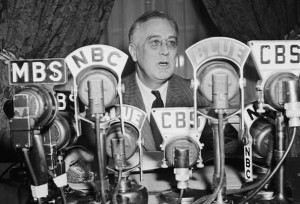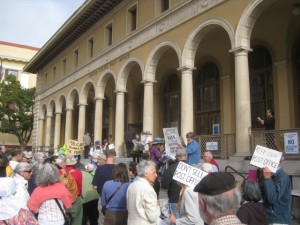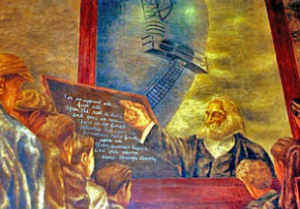World War II interrupted, postponed, and ultimately altered what became the last New Deal art project. Artist Anton Refregier embarked on his monumental mural cycle for San Francisco’s Main Post Office in 1946. He began with a study of a heroic, solitary California Indian, and—27 panels and 18 months later—culminated with thesigning the United Nations Charter at that city’s Veterans Memorial Building.

War and Peace
The signing of the U.N. Charter. Mural by Anton Refregier
Photo Credit: Creative Commons
That event is depicted in a triptych terminating in the post office’s long lobby in which Refregier’s also depicted the horrors of the recent war, multiracial representatives gathered to end war, and Franklin Roosevelt’s face bridging the two. Almost immediately after Roosevelt’s death, reaction set in even as Refregier was still painting.
Refregier had used a photograph of FDR taken after the president’s return from signing the peace treaty at Yalta. “It is a tired, sensitive, and completely beautiful face,” he wrote, “one expressing Roosevelt to me.” He wanted that face to act as a bridge between war and peace and to dedicate the mural cycle to the man “who lives in the heart and minds of the people,” and whose ultimate plan for an international mediating body would, many hoped, end war forever. Hiroshima had demonstrated that the next world war would be the world’s last.
But Refregier’s new bosses in Washington ordered him to delete FDR’s portrait. After resisting the order for seven months, the artist capitulated by replacing the face with a family group representing the Four Freedoms, which Roosevelt had enunciated in his 1941 State of the Union address. Freedom of speech and religion, FDR insisted, must be added to freedom from fear and from want everywhere in the world.
Regregier’s personal papers indicate that he understood the larger implications of the order to remove FDR’s face from this very public building. “The fight was lost[s1] !… The [political] climate was changing. It was necessary to erase the image of Roosevelt and his plans for coexistence and Peace… in order to see the American people on [to] the Cold War.” When Congressmen sought to destroy the murals in 1953, Refregier wrote, “the attack is part of reaction’s drive to destroy the significance of the 1945 U.N. Conference in San Francisco.”
Refregier was not wide of the mark. Although the signing of the U.N. Charter was one of the outstanding events in San Francisco’s history, it is largely forgotten today.
Virginia Gildersleeve, the Dean of Barnard College who attended the conference and who crafted the opening to the charter’s preamble based on that of the United States Constitution, said in her memoirs that Roosevelt’s sudden death “lay like a black shadow over all the world and particularly over the small nations who had pinned their hopes on him.”
As war becomes perpetual in the 21st century, we should remember that under that black shadow, the nations of the world once gathered to abolish it in his memory.



